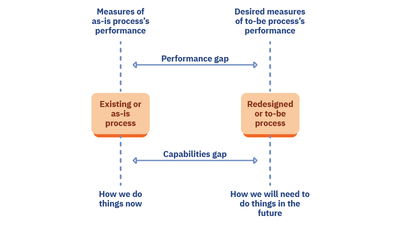Business processes and business process problems: definition and categories
Written by Andrea
22 June 2023 · 9 min read

Efficient and well-structured processes play an essential role in determining an organization's success. Businesses across industries rely on streamlined workflows and effective business processes to improve productivity, enhance customer experience, and drive growth.
In this blog post, we’ll define what business processes entail and why they are essential for sustainable success. From there, we'll explore the various business process problems that project teams frequently encounter. We'll also touch briefly on one of the problem-solving methods teams often use when dealing with a process improvement project.
What is a business process?
Generally, a process is any logical series of related activities that convert inputs into outputs. But the definition is a bit elaborated when it comes to business processes.
A business process is a sequence of logically connected, sometimes repetitive, activities or tasks that use a company’s resources to achieve a specific valued and measurable result for internal or external stakeholders. Simply put, it’s a collection of activities that takes one or several types of inputs and creates an output that is valuable to the customer. Nowadays, a business process can also be described as several roles collaborating and interacting to achieve a common goal.
Irrespective of which definition one subscribes to, it’s important to emphasize the repetitiveness of business processes as a key characteristic. Repeating a specific business process – for example, a bank loan process - many times a day across the globe makes investing in its further improvements worthwhile. However, not only processes that are repeated to this extreme can benefit from careful design.
Let’s take as an example a local professional home painter. By designing the process of painting the exterior of a house before executing it - from where to put the paint bucket to reach it easily to in what order to paint the different sections of the house - the local painter can optimize the painting process and, consequently, enjoy significant time savings and improve customer satisfaction.
Business processes exist in every aspect of an organization, ranging from manufacturing operations to finance and human resources. They’re specific, flexible, measurable, repeatable, and have clear start and end points.
Business processes are essential for ensuring consistency and improving organizational efficiency and effectiveness. By mapping and documenting processes, organizations can identify bottlenecks and optimize workflows. When designed and executed correctly, business processes can enable companies to deliver high-quality products and services, decrease costs, and improve customer satisfaction.
Types of business processes
There are several ways of classifying business processes. However, one stands out the most and is also in line with the thinking of Porter’s value chain. According to that method, business processes fall within two groups:
-
Primary processes: the core and value-creating processes that help an organization generate income and survive in the market. They run straight through the company, from receiving goods from suppliers to activities on the customer side. For example, the process of replenishing the stock of vehicles of a car rental business is a primary process.
-
Secondary processes: the activities that support the execution of primary processes and don’t create value directly. For instance, financial management and internal control of HES (Health, Environment and Safety) are secondary business processes.
To complicate things, part of the support processes can be put into a new group called development processes. The latter takes a company’s value chain and its primary and support processes to a new higher level of performance. They include activities such as supplier base development and personnel training.
Simple vs. complex business processes
Business processes consist of a wide range of elements, including but not limited to:
- Inputs: the resources or information necessary to initiate or carry out a process.
- Outputs: the desired results, products, or services produced at the end of a process.
- Rules, policies, and guidelines: the defined procedures and standards that govern the execution of the process.
- Communication and collaboration: the exchange of information between the people involved in the process.
Depending on the number of elements involved, business processes are usually either very simple or highly complex.
Simple business processes follow a well-defined step-by-step sequence of tasks with clearly defined rules. Each task is precisely defined, and the sequence contains no branches or exceptions. Examples include bookkeeping and retail sales.
On the other hand, complex business processes involve branches and exceptions. They tend to be slightly less well-defined, and usually draw on many rules. They also require more initiative from employees. Some of these processes are so complex that their automation is impossible. In such cases, companies need to hire people with advanced education who have the required analytic or creative skills. Examples include consulting, software system design, and new product development.
What is a business process problem?
A business process problem is the difference between what exists now and what is desired. Any new business project often begins with at least one problem. The challenge, however, is not in finding out that there is a problem. It’s in figuring out the nature of the problem and how to overcome it.
Business process problems can manifest in various forms, such as bottlenecks, errors, inefficiencies in the execution of tasks, or lack of coordination. These problems can result from a range of factors, including outdated technology, lack of clear documentation, ineffective communication, inadequate training, complex processes, or changing business requirements.
Identifying and addressing business process problems is crucial for companies aiming to improve their operations, reduce costs, enhance customer satisfaction, streamline procedures, and gain a competitive edge. This often involves analyzing the existing business processes, mapping out the flow of activities, identifying problematic areas, and implementing appropriate solutions to achieve the desired outcomes.
Types of business process problems
There are six types of business process problems that a project team may identify during the analysis of a process:
- input problems
- output problems
- problems with controls
- problems with enablers
- process flow problems
- day-to-day management problems.
Project teams usually encounter the first four types of problems when using a process scoping diagram to analyze the relationship between a process and its external environment. The other two types - process flow problems and day-to-day management problems - are typically discovered during the analysis of the internal environment of a business process.
Input process problems
An input problem appears when the “suppliers” of the business process, such as companies or other processes, don’t deliver what the process needs to start. An input to the process can be deficient in one or several of the following:
- Quality – for example, rejection of the input due to non-compliance with the quality standards of the process.
- Quantity – for example, the supplier doesn’t produce the necessary inputs.
- Timeliness – inputs arrive in batches and have to be stored until needed, or some or all of the inputs don’t arrive when needed.
Inputs can take different forms such as physical entities, information, approvals, and decisions.
Addressing input process problems often requires establishing robust input management procedures, implementing quality control measures, and encouraging transparent communication between the stakeholders involved in the process.
Output process problems
An output problem occurs when the output of the process, such as physical entities, data, or decisions, doesn’t meet the expectations of the “customers” (for instance, a stakeholder or another process). This usually happens when the outputs are unrealistic or unnecessary, and it could even be due to the lack of compliance with local regulations.
However, similarly to inputs, output problems may also result from one or more of the following:
- Quality – for example, rejection of the output by a quality control process downstream.
- Quantity – for example, the process doesn’t produce the necessary number of outputs.
- Timeliness – some or all the needed outputs aren’t produced when required.
To address output process problems, companies need to implement quality control measures, improve documentation practices, have better communication channels, and ensure continuous monitoring and evaluation of the outputs.
Problems with controls
Controls determine or limit the performance of a business process. They’re mechanisms put in place to ensure that business processes are executed effectively and efficiently. For instance, a type of process control is the business strategy developed by higher-level managers. Thus, problems with controls can occur when there is a misalignment between the strategy and the business process.
Broadly, control problems can be associated with:
- Organization goals – for example, the strategy associated with the supply chain management process is unclear or incompatible with the process in scope.
- Policies and business rules – for example, the process consistently ignores specific business rules.
- Documentation, manuals, and similar – for instance, documentation is incomplete, outdated, written in the wrong language, or completely wrong.
- External management processes – for example, an external process requires information that the process in scope can’t provide.
Businesses can address problems with controls by using methods such as conducting risk assessments and implementing robust control frameworks.

Problems with enablers
Problems with enabling or supporting processes happen when those processes fail to deliver or maintain the resources needed by the business process in scope. These problems often originate from activities related to, as follows:
- Information technology – for instance, the IT applications require inputs that are out of sync with the activities of the process.
- Human resources – for example, the employees involved with the process lack the time or tools required for the execution of the tasks in the process.
- Facility, equipment, and location – for example, the equipment required by the process is inadequate.
- Accounting and bookkeeping – for instance, financial data needed for making decisions in the process is unavailable.
Enablers come from other processes, organizations, systems, or external stakeholders. They're the technologies and facilities used in the process or the people assigned to it that support and enhance the execution of the business process.
Process flow problems
Process flow problems appear when there are issues within the flow of the subprocesses or activities of the business process in scope. There are five main types of process flow problems:
- Problems with logical completeness – some inputs or outputs have no place to go, or relevant activities have no connection with one another.
- Sequencing and duplication problems – for example, the execution of some activities is in the wrong order or happens more than once.
- Problems with subprocess measures – the subprocess measures are inadequate, or there are no measures whatsoever for the quality, quantity, or timeliness of subprocess outputs.
- Process decision-making problems – for instance, the process in scope, or one of its subprocesses or activities, needs to make decisions without adequate or complete direction from the organization.
- Subprocess input and output problems – for example, some subprocesses get inputs and produce unnecessary outputs.
These problems can hinder the smooth and efficient execution of the business process, leading to delays, errors, and decreased productivity. Identifying process flow problems can happen through process mapping, analysis, and optimization and can help companies increase efficiency, reduce costs, and deliver better outcomes.
Day-to-day management problems
The last type of process problems relates to the management of the business process as a whole and each of its subprocesses or activities. Focus areas of day-to-day management problems may include the following:
- Planning and resource allocation: the process manager receives lagging data that doesn’t provide information on how to use it for anticipating work, plans, or schedules.
- Monitoring, feedback, and control: the employees working on the business process don’t receive adequate information about the performance of the process they’re responsible for managing.
- Manager accountability: the process manager isn’t held responsible for accomplishing one or more key process goals.
- Manager’s goals and incentives conflicted: the process manager lacks the authority or resources to manage the process effectively.
It’s important for organizations to identify and address day-to-day management problems to optimize their business processes, enhance productivity, and achieve their goals.
Solving business process problems
A helpful method for business process problem-solving is the gap model. This model consists of two main sections: a left side and a right side. The former presents the existing business situation or the as-is process, while the latter illustrates the desired, redesigned situation or the to-be process.

A project team can use the gap model in one of two ways:
- as a performance gap model that focuses on the measures describing the performance of the business process,
- or, as a capability gap model that describes how the as-is or to-be process works.
For example, the project team may need to find a way to automate a specific process or double its output.
One problem that any project team eventually encounters is the difference between descriptions of actual problems and descriptions of consequences. Subsequently, the project team must often ask one of two questions: "Why did this happen?" or "Why is this a problem?". Furthermore, management will usually provide the project team with measures or statistics that are actually measures of consequences. As a result, the team must work backward to identify the problem that needs solving to achieve the specified measures.
In addition to all the above, a gap model can provide a framework for thinking about the analytics techniques a project team might want to use to define the problem. And it can even suggest the improvement methods the team could use to solve the problem.
Visualizing business processes with Cardanit
Cardanit is a modern BPMN editor designed to help project teams create, edit, and visualize business process models effectively using the BPMN 2.0 standard.
Cardanit provides a user-friendly interface where users can draw and model various elements of a business process. These elements typically include activities, events, gateways, flows, and artifacts. Users can perform many activities, including but not limited to:
- Determine the specific business process they want to scope and analyze.
- Create a high-level overview of the process and gradually drill down to more detailed subprocesses.
- Use the drag-and-drop functionality to select BPMN elements from a palette and add them to the process flow diagram.
- Define the structure and flow of the process by connecting elements and specifying the sequence and conditions for process activities.
- Analyze the process model to identify potential problems, such as bottlenecks, inefficiencies, delays, or any other issues hindering process effectiveness or efficiency.
- Use annotations and comments to highlight the identified problems directly on the diagram.
- Use the collaboration features, enabling multiple users to work on the same process flow model simultaneously, providing real-time updates, and facilitating team collaboration.
- Import and export process models in PNG or PDF formats.
Overall, Cardanit enables organizations to document, analyze, and optimize their processes visually. Our software tool provides a common language for stakeholders, including business analysts, project managers, and developers, to understand, communicate, and improve business processes efficiently.
In conclusion
Business processes are essential for the success of any organization. They provide structure and order to the various tasks and activities that drive its operations. If well-defined and correctly executed, they can enhance efficiency, productivity, and overall business performance. However, business processes are not immune to problems and challenges, and while business process problems are inevitable, they aren’t impossible to overcome. By improving business processes, companies can enjoy new levels of efficiency, productivity, and success.
Further reading
BPMN in supply chain process management: How to model end-to-end processes
Business processes in public administration: Improving public services with BPMN
Andrea is the collective pseudonym for the group of people working behind Cardanit, the Business Process Management Software as a Service of ESTECO. The group has different backgrounds and several decades of experience in fields varying from BPM, BPMN, DMN, Process Mining, Simulation, Optimization, Numerical Methods, Research and Development, and Marketing.
Andrea is the collective pseudonym for the group of people working behind Cardanit, the Business Process Management Software as a Service of ESTECO. The group has different backgrounds and several decades of experience in fields varying from BPM, BPMN, DMN, Process Mining, Simulation, Optimization, Numerical Methods, Research and Development, and Marketing.
Learn what key features and ingredients your BPMN editor should have to ensure a smooth and efficient business process mapping experience.
Key ingredients for efficient process mapping
Learn what key features and ingredients your BPMN editor should have to ensure a smooth and efficient business process mapping experience.
Key ingredients for efficient process mapping
Learn what key features and ingredients your BPMN editor should have to ensure a smooth and efficient business process mapping experience.
